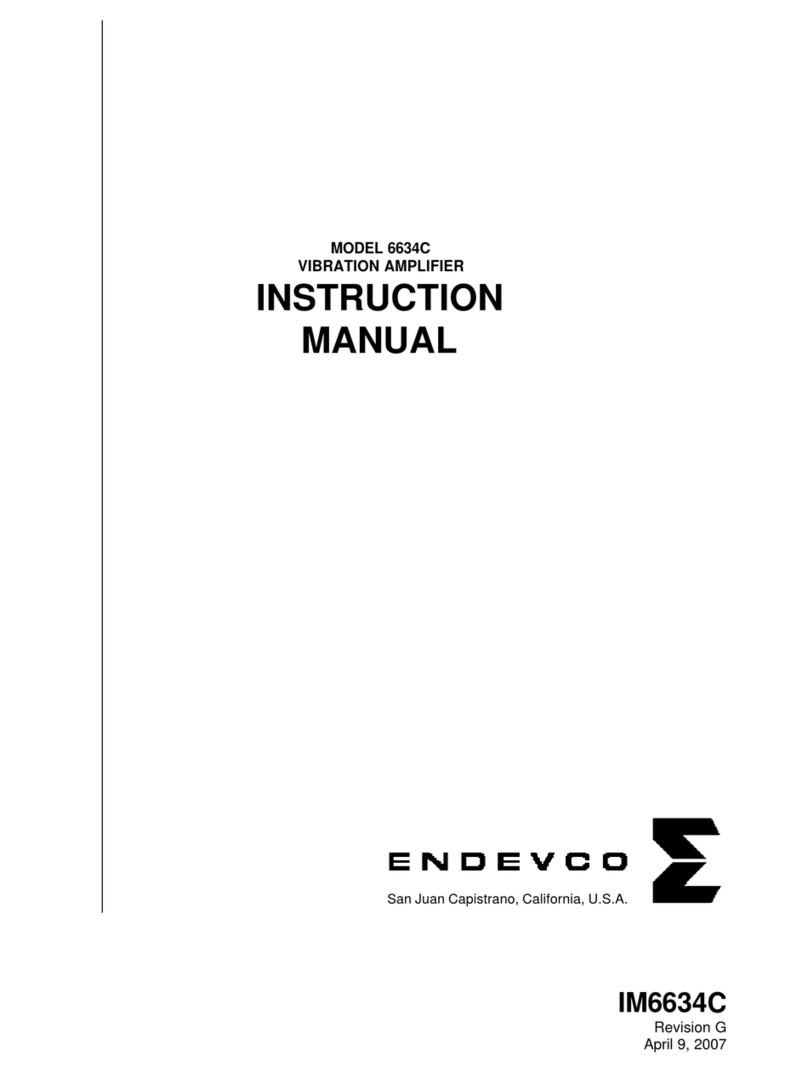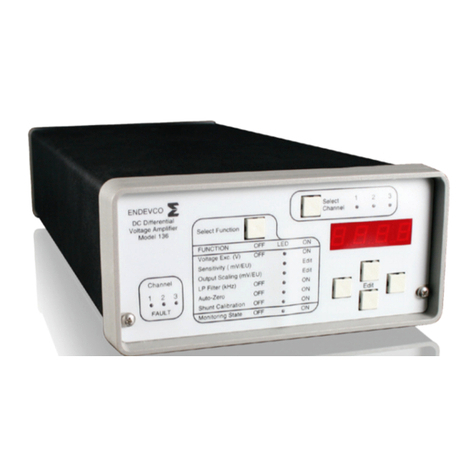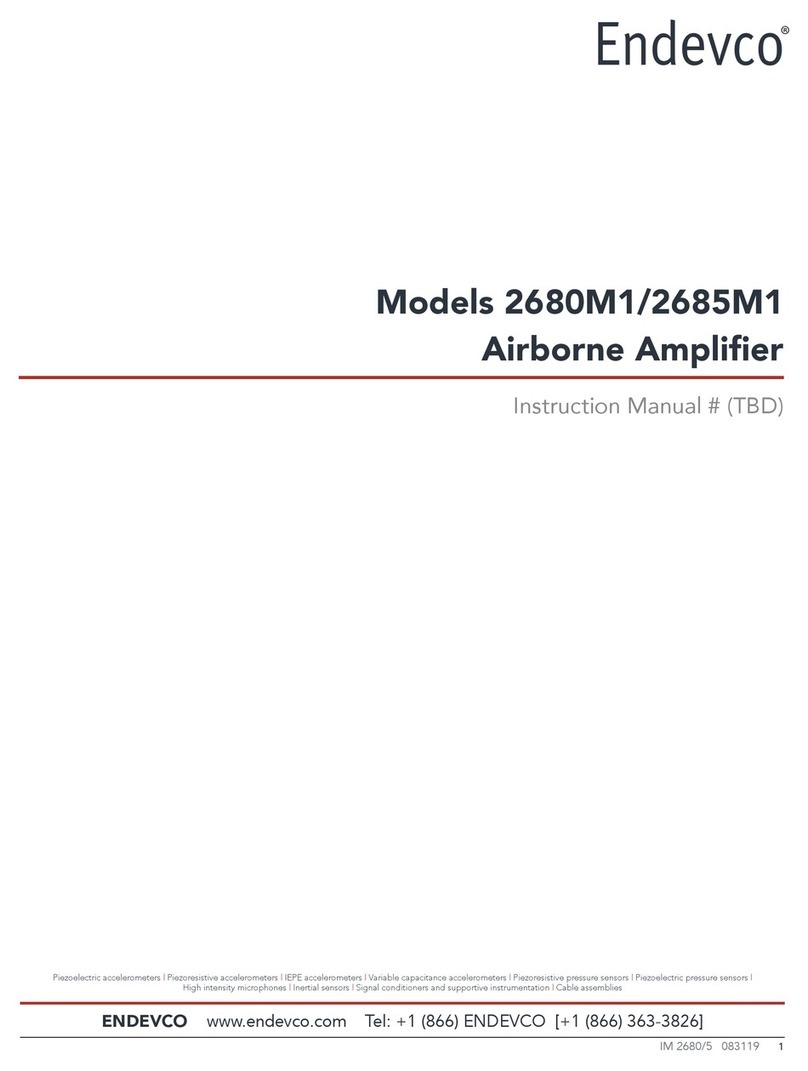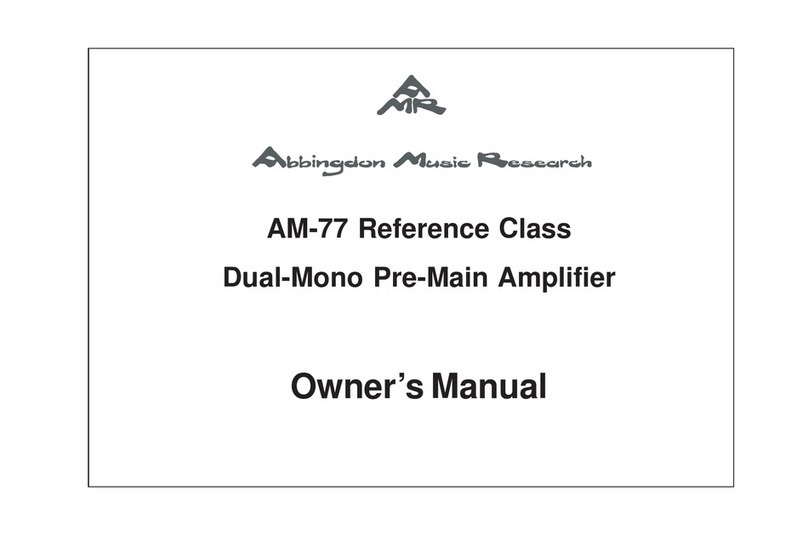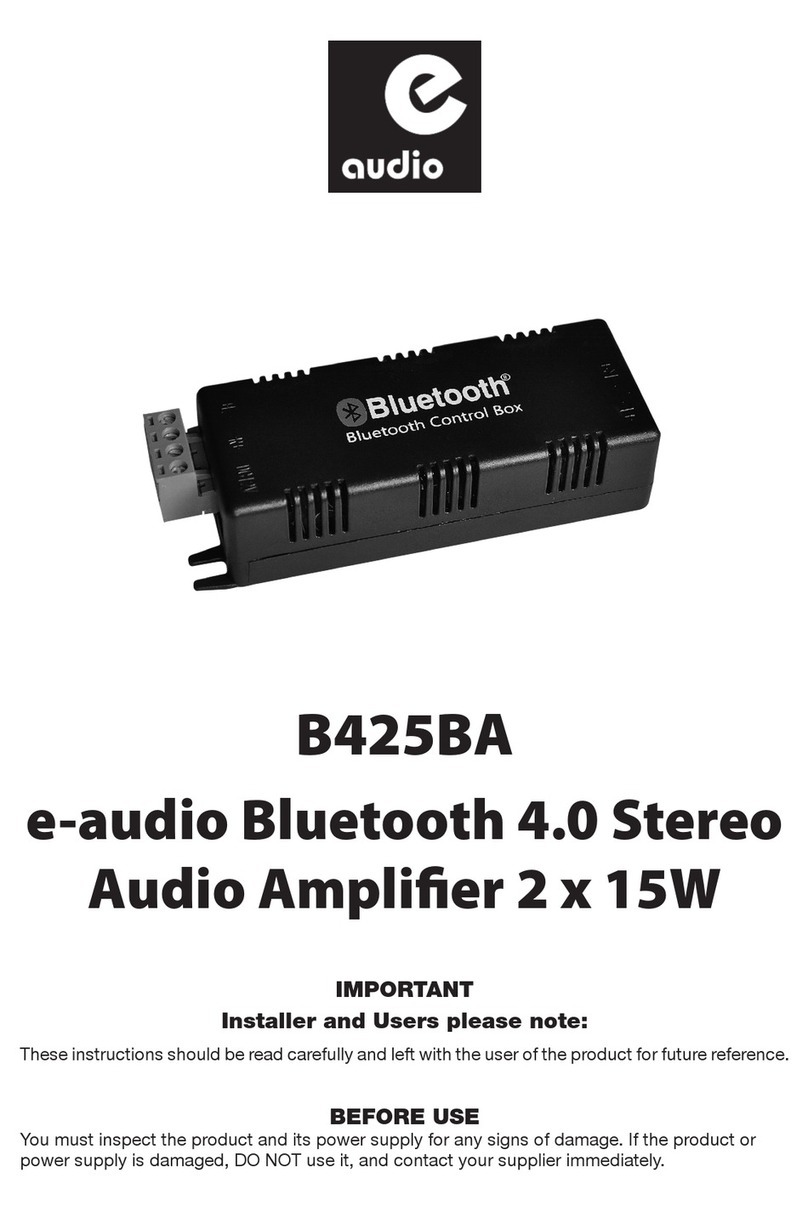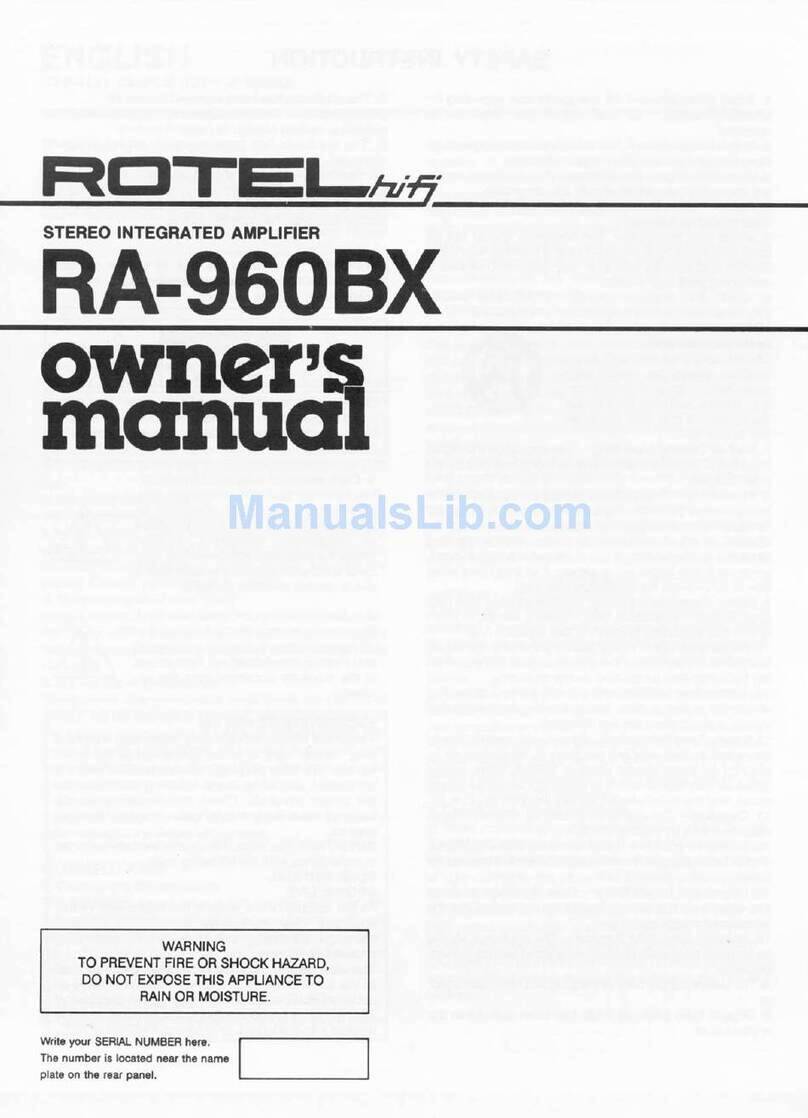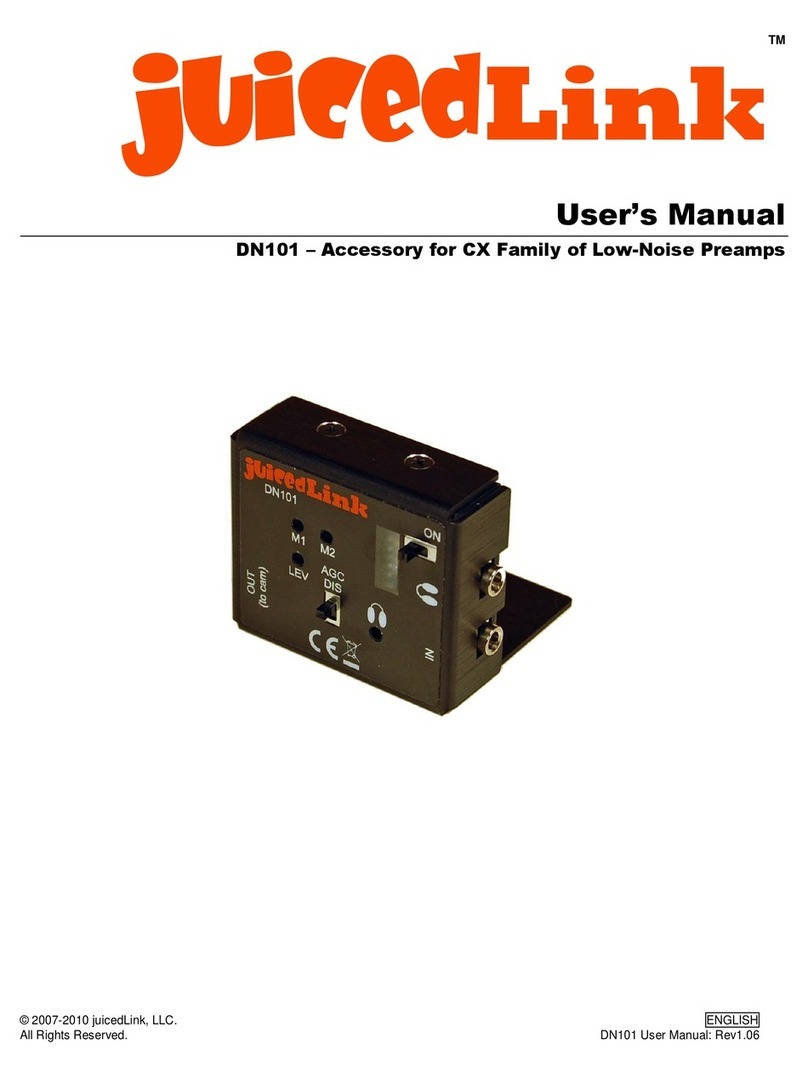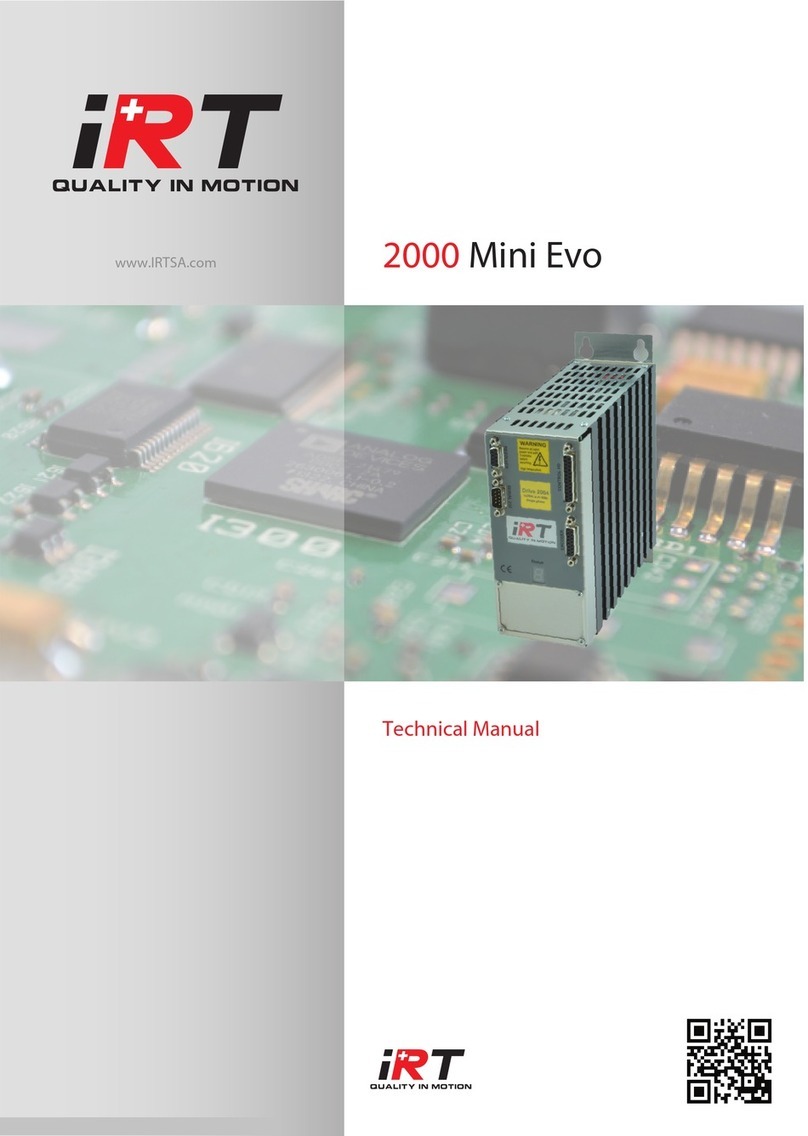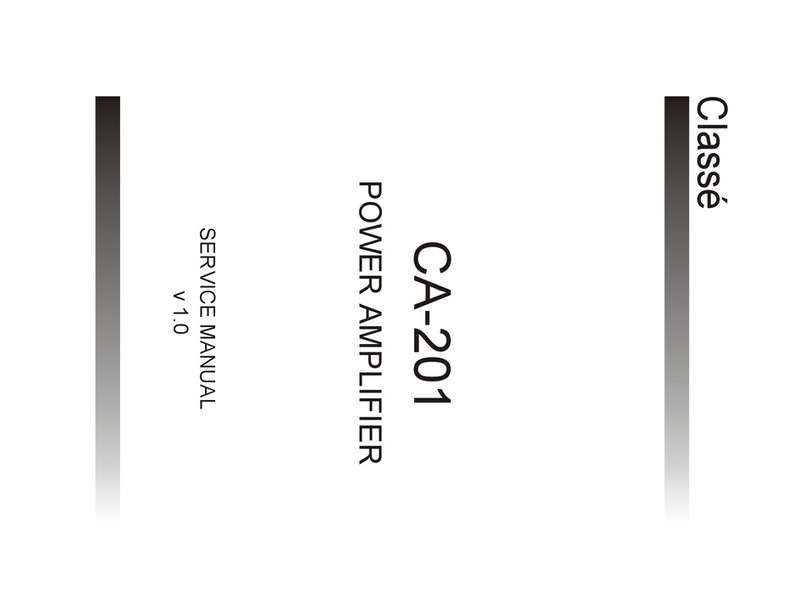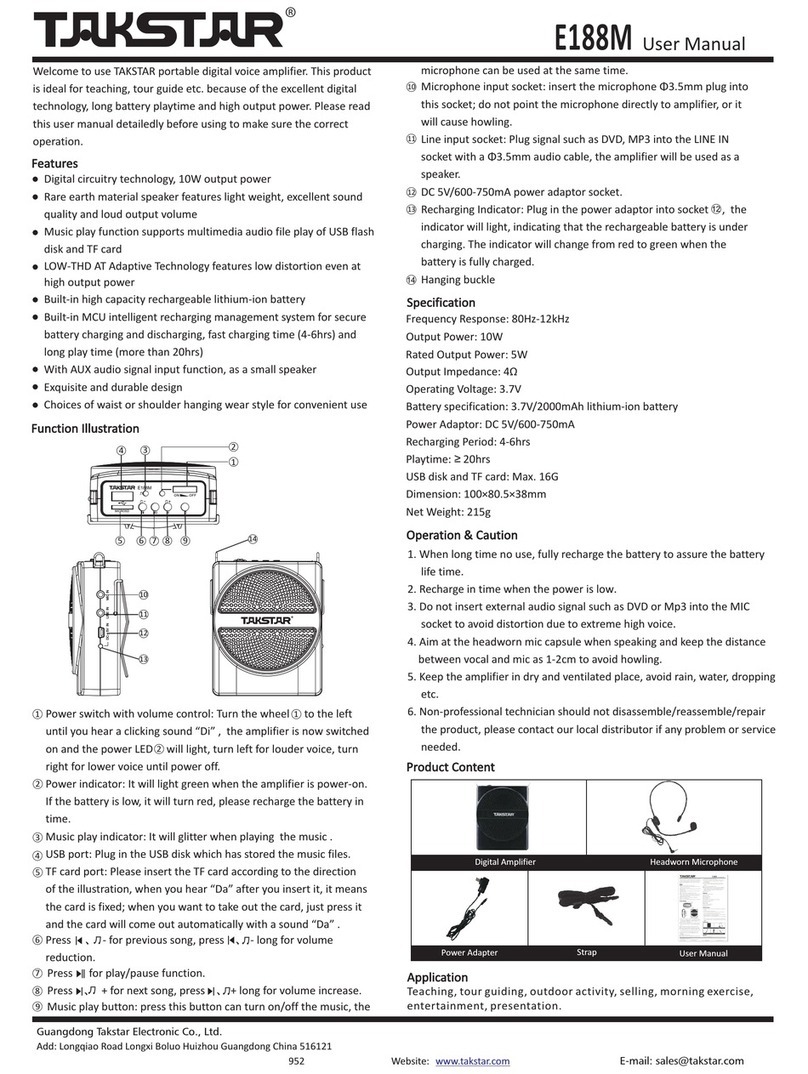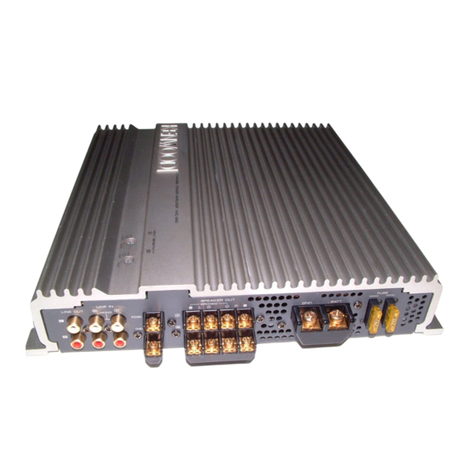ENDEVCO 2680 Series User manual

IM2680
Revision B
Nov 1, 91
MODEL 2680M1-M7/2680M12-M14/2680M61-67/2681M1-M7/2685M1-M7
AIRBORNE CHARGE AMPLIFIER
INSTRUCTION
MANUAL

IM2680
Revision B
Nov 1, 91
San Juan Capistrano, Calif ornia, U.S.A.

ENDEVCO 2680
INSTRUCTION MANUAL
IM2680
Page C-1
TABLE OF CONTENTS
SECTION 1: DESCRIPTION PAGE
1. INTRODUCTION 1-1
2. ADJUSTABLE GAIN 1-1
3. OUTPUTS 1-2
4. DC-TO-DC CONVERTER 1-3
5. INPUT POWER 1-3
6. OPTIONAL FILTERS 1-4
7. ACCESSORIES 1-4
8. APPLICATION 1-4
SECTION 2: INSPECTION AND INSTALLATION
1. INSPECTION 2-1
2. INSTALLATION 2-1
SECTION 3: PRE-OPERATION TEST
1. INTRODUCTION 3-1
2. EQUIPMENT REQUIRED 3-1
3. VOLTAGE INSERTION TEST PROCEDURE 3-2
4. ALTERNATE TEST METHOD 3-3
SECTION 4: OPERATIONAL CHECKOUT PROCEDURE
1. USING THE CHARGE AMPLIFIER 4-1
2. GAIN ADJUSTMENT 4-1
3. AMPLITUDE LINEARITY 4-2
4. FREQUENCY RESPONSE 4-3
5. DC-TO-DC CONVERTER 4-3
APPENDIX A: THEORY OF OPERATION
1. INTRODUCTION A-1
2. CHARGE CONVERTER A-2
3. GAIN POTENTIOMETER A-3
4. VOLTAGE AMPLIFIER A-3
5. TRANSFER CHARACTERISTICS A-3

ENDEVCO 2680
INSTRUCTION MANUAL
IM2680
Page C-2
TABLE OF CONTENTS - continued
APPENDIX B: GAIN ADJUSTMENT PAGE
1. THEORETICAL GAIN ADJUSTMENT B-1
2. PRACTICAL GAIN ADJUSTMENT B-2
3. REMOVAL AND RESEALING GAIN-ACCESS SCREWS B-3
4. REMOVING ACCESS SCREWS B-4
5. SEALING ACCESS SCREWS B-4
LIST OF ILLUSTRATIONS
3-1 VOLTAGE INSERTION TEST SETUP 3-2
3-2 ALTERNATE CHARGE INSERTION TEST SETUP 3-3
4-1A TYPICAL SYSTEM CONNECTIONS WITH CHARGE AMPLIFIER 4-2
4-1B TYPICAL SYSTEM CONNECTIONS WITH ISOTRON CONDITIONER 4-2
A-1 PIEZOELECTRIC TRANSDUCER EQUIVALENT CIRCUIT A-1
A-2 BASIC AIRBORNE CHARGE AMPLIFIER FUNCTIONAL BLOCK DIAGRAM A-3
A-3 TYPICAL SYSTEM EQUIVALENT CIRCUIT A-4
B-1 TYPICAL GAIN CALIBRATION TEST SETUP B-2
B-2 GAIN ADJUST FOR CHARGE AMPLIFIERS WITHOUT DC-TO-DC CONVERTERSB-5
B-3 GAIN ADJUST FOR CHARGE AMPLIFIERS WITH DC-TO-DC CONVERTERS B-5

ENDEVCO 2680
INSTRUCTION MANUAL
IM2680
Page 1-1
SECTION 1:
DESCRIPTION
1. INTRODUCTION
The Endevco® Model 2680 Series of Charge Amplifiers are Solid-State Airborne Devices
designed for use with Piezoelectric Transducers. The Charge Amplifiers are epoxy-potted and
hermetically sealed units containing a charge converter front end to receive the transducer signal,
an optional filter to select the flat frequency response of the charge amplifier, a gain potentiometer
to set the desired gain of the charge amplifier, and a voltage amplifier in the output. The charge
amplifier produces an output voltage proportional to the charge at the input, thus minimizing the
effect of input cable length. The charge amplifier uses hybrid microcircuits to achieve small size,
low weight, and low power consumption.
The case of each charge amplifier is completely isolated from the circuit, and an internal
electrostatic shield protects from stray pickup. A DC-to-DC Converter installed in specific models
isolates power and signal grounds.
The series of charge amplifiers covered by this instruction manual are listed below with a brief
description defining each configuration. As noted the difference between the basic charge
converter Models (2680 & 2681) is the type of output connectors used and the addition of the DC-
to-DC Converter. Table 1-1 provides a further breakdown between the basic models.
Basic Model Configuration
2680 Viking Connector
2681 Viking Connector, DC-to-DC Converter
2685 Endevco Connector, DC-to-DC Converter
Integral Electronic Conditioner with constant current supply
Each basic model consists of a series of modifications ("M series) to provide seven different gain
ranges and nine different high frequency responses. The "M" series covered by this Instruction
Manual are M1 thru M7, M12 and M14. Table 1-2 lists the "M" series and provides a comparison
of their input and output characteristics.
2. ADJUSTABLE GAIN
The Charge Amplifier's case contains a removable screw to permit access to a Gain
Potentiometer. The Potentiometer enables the user to adjust the gain to any desire setting within
the gain range of the Charge Amplifier.
The Gain-Access Screw is located on the side of the case for Charge Amplifiers without DC-to-DC
Converters, and on the connector end of the case for Charge Amplifiers with DC-to-DC
Converters. Refer to Table 1-1 for the basic model numbers of Charge Amplifiers containing the
DC-to-DC Converters, and to Figures B-2 and B-3 for location of the Gain Adjustment.
The Gain Adjustment is a 12-turn (typical), 500 kΩ (±0,1%) Potentiometer with wiper idles as
mechanical stops at the extreme clockwise (CW) and counterclockwise (CCW) positions.
Maximum resistance (minimum Charge Amplifier Gain) is obtained in the extreme CW position.
Signals are present at both ends of the Potentiometer, but signal changes may not occur during
the final two turns.
Charge Amplifiers shipped as a component of an Endevco system (Accelerometer, Cable
Assembly and Charge Amplifier) normally have the gain factory-set to a specific gain, and the
Gain-Access Screw Solder-Sealed to the case of the Charge Amplifier. The Gain-Access Screw

ENDEVCO 2680
INSTRUCTION MANUAL
IM2680
Page 1-2
must be sealed to the case with solder, glyptol or epoxy for the Charge Amplifier to meet humidity
specifications during operation.
Charge Amplifiers shipped as single items of equipment have the Gain Potentiometer set to the
maximum rated gain of the Charge Amplifier, and the Gain-Access Screw temporarily seated in
the threaded access hole. Users of the Charge Amplifier are then required to adjust the gain to a
desired gain setting prior to application of a Charge Amplifier (see Paragraph 4.2). Table 1-2 lists
the gain ranges for each "M" series (M1 thru M7, M12 and M14) of Charge Amplifiers.
____________________________________________________________________________
___Power Requirements____
Current
Basic Input Output DC-to-DC Voltage M1-M7 M12, M14
Model Connector Connector Accessories Conv. VDC mA DC mA DC _
2680 Microdot 51-49 Viking VR5/4AG15 Endevco Kit 21997 consisting of: No 20-32 V < 20 < 25
10-32 Endevco P/N EP30 Mating Plug - Viking VP5/4CE6 28 V typ
UNF-2A thread 5-Pin connector Hood - Viking VS4/16C5
Potting Sleeve-VikingVS4/16C9
Mounting Hardware - Two #6-32
Captive Screws w/ Lockwashers
2681 Microdot 51-49 Viking VR7/4AG15 Endevco Kit 23318 consisting of: Yes 24-32 V < 30 < 35
10-32 Endevco P/N EJ277 Mating Plug - Viking VP7/4CE6 28 V typ
UNF-2A thread 7-Pin connector Hood - Viking VS4/16C5
Potting Sleeve-VikingVS4/16C9
Mounting Hardware - Two #6-32
Captive Screws w/ Lockwashers
2680 Microdot 51-49 Viking VR7/4AG15 Endevco Kit 21997 consisting of: Yes 20-32 V < 30 < 35
10-32 Endevco P/N EJ277 Mating Plug - Viking VP5/4CE6 28 V typ
UNF-2A thread 7-Pin connector Hood - Viking VS4/16C5
Potting Sleeve-VikingVS4/16C9
Mounting Hardware - Two #6-32
Captive Screws w/ Lockwashers
______________________________________________________________________________________________________
TABLE 1-1: CONNECTORS, ACCESSORIES, AND POWER REQUIREMENT
3. OUTPUTS
Each Charge Amplifier has two outputs, biased and/or unbiased. The outputs can be a
combination of a biased and an unbiased, or both outputs can be biased, or both outputs can be
unbiased. The "M" number following the model number is the determinant (see "Types of Output"
column in Table 1-2). Both outputs are single-ended with one side connected to circuit ground.
When both outputs for the M1 through M7 are used simultaneously, the parallel combination of
both load resistances must be 10 kΩor greater to meet all specifications. For the M12 and M14,
both outputs can be loaded with 10 k ohms or greater simultaneously and still meet all
specifications. Maximum output voltage is approximately 0 to 5 v (±2.5 v pk) depending on the
specific Charge Amplifier. The output circuits are short-circuit proof, thus the outputs will
withstand an indefinite short without damage.
The biased outputs are direct coupled with an output impedance of less than 50 Ω. With no
input, the Charge Amplifier produces +2.5 V dc ±3% at the output. Output voltage will be
approximately ±2.5 V pk around this bias level. Clipping will occur slightly about the 0 V level and
between +5.0 and +5.3 V. The unbiased outputs are in series with a minimum 16 uF capacitance
and have an output impedance of less than 50 Ω. With the addition of the series capacitor and
bleed resistor in the output, a 0.00 V bias level is established. The unbiased output is linear from
0 to 4.65 V p-p, or 0 to 5.00 V p-p, depending on the specific Charge Amplifier used.
Refer to Table 1-2 for further output data on specific "M" series Charge Amplifiers.

ENDEVCO 2680
INSTRUCTION MANUAL
IM2680
Page 1-3
____________________________________________________________________________
_____________________________________________Output Characteristics______________________
DC Output Voltage Minimum Linear Output___________
Biased
Input Adjustable Residual Unbiased Voltage Unbiased Voltage Current (10kΩ
Model Charge Gain Range Noise Type Biased (+0.50/ (≥10kΩ >10kΩ >1MΩ Load at Min.
M No. Limit (pC) mV/pC (mV rms) Output (±3%) -0.00) Load) Load Load Linear Voltage )
M 1 50 000 0.1 to 1.0 1.5 Biased/ 2.5 V 0.00 V 4.65 Vp-p 4.25 Vp-p 4.65 Vp-p 0.465 mA p-p
Unbiased 1.64 Vrms 1.5 Vrms 1.64 Vrms 0.164 mA rms
M 2 25 000 0.2 to 2.0 1.5 Biased/ 2.5 V 0.00 V 4.65 Vp-p 4.25 Vp-p 4.65 Vp-p 0.465 mA p-p
Unbiased 1.64 Vrms 1.5 Vrms 1.64 Vrms 0.164 mA rms
M 3 10 000 0.5 to 5.0 1.5 Biased/ 2.5 V 0.00 V 4.65 Vp-p 4.25 Vp-p 4.65 Vp-p 0.465 mA p-p
Unbiased 1.64 Vrms 1.5 Vrms 1.64 Vrms 0.164 mA rms
M 4 5 000 1.0 to 10 1.5 Biased/ 2.5 V 0.00 V 4.65 Vp-p 4.25 Vp-p 4.65 Vp-p 0.465 mA p-p
Unbiased 1.64 Vrms 1.5 Vrms 1.64 Vrms 0.164 mA rms
M 5 2 500 2.0 to 20 1.5 Biased/ 2.5 V 0.00 V 4.65 Vp-p 4.25 Vp-p 4.65 Vp-p 0.465 mA p-p
Unbiased 1.64 Vrms 1.5 Vrms 1.64 Vrms 0.164 mA rms
M 6 1 000 5.0 to 50 1.5 Biased/ 2.5 V 0.00 V 4.65 Vp-p 4.25 Vp-p 4.65 Vp-p 0.465 mA p-p
Unbiased 1.64 Vrms 1.5 Vrms 1.64 Vrms 0.164 mA rms
M 7 500 10 to 100 2.0 Biased/ 2.5 V 0.00 V 4.65 Vp-p 4.25 Vp-p 4.65 Vp-p 0.465 mA p-p
Unbiased 1.64 Vrms 1.5 Vrms 1.64 Vrms 0.164 mA rms
M12
Low 5 000 1.0 to 10 1.5 Biased 2.5 V 0.00 V 4.65 Vp-p 0.465 mA p-p
Gain 1.64 Vrms 0.164 mA rms
High 5 000 10 to 100 7.5 Biased 2.5 V 0.00 V 4.65 Vp-p 0.465 mA p-p
Gain 1.64 Vrms 0.164 mA rms
M14
Low 5 000 1.0 to 10 1.5 Unbiased 2.5 V 0.00 V Limited at 0.500 mA p-p
Gain 5.00 Vp-p 0.177 mA rms
1.77 Vrms
High 5 000 10 to 100 7.5 Unbiased 2.5 V 0.00 V Limited at 0.500 mA p-p
Gain 5.00 Vp-p 0.177 mA rms
1.77 Vrms
______________________________________________________________________________________________________
TABLE 1-2: INPUT/OUTPUT CHARACTERISTICS
4. DC-TO-DC CONVERTER
A DC-to-DC Converter is installed in specific models of the Charge Amplifier (see Table 1-1) to
isolate power and signal grounds. The isolation of the grounds is required when power is noisy, or
when switching transients are present, or when separate grounds have already been established
in a measurement system.
5. INPUT POWER
The Charge Amplifiers operate from a 20 to 32 V dc source (28 V typically). Each model may
vary in voltage range and input current requirements, this is dependent on the installation of a DC-
to-DC Converter. Refer to Table 1-1 for input voltage and current requirements for each Charge
Amplifier model and "M" series.

ENDEVCO 2680
INSTRUCTION MANUAL
IM2680
Page 1-4
6. OPTIONAL FILTERS
An optional low-pass filter is factory installed in the Charge Amplifier if specified on the Customer
Purchase Order. Optional filters are available in two, four, and six pole low-pass Butterworth
configurations that provide the Charge Amplifier with a specific frequency response. If a Charge
Amplifier contains an optional filter, the model number will contain a three-digit suffix (dash
number) to indicate the filter's 5% frequency in Hz. The first two digits are significant numbers
and the third indicates the numbers of zeroes. As an example, the Model 2680M12-101 Charge
Amplifier has two-pole low-pass filter installed with a flat response up to 100 Hz. Table 1-3
provides a list of the various filters by dash number and frequency responses of each.
7. ACCESSORIES
Accessories for the series of Charge Amplifiers vary according to the type of output connector
installed on the unit. All Charge Amplifiers are shipped with mounting hardware, and those units
with output connectors installed will have a mating connector for connecting input power and
readout devices.
8. APPLICATION
The Model 2680 Series of Airborne Charge Amplifiers are ideally suited for inflight telemetry
applications and other dynamic instrumentation systems using Transducers such as Piezoelectric
Accelerometers, Microphones, Force Gages or Pressure Pickups. The small size, light weight,
low-power consumption, and the use of long cables to connect Transducers to the Charge
Amplifier, enables the unit to be used in ground and laboratory testing, rocket test stands,
combined environmental testing, steam turbines and other industrial applications.
____________________________________________________________________________
Model Low Frequency High Frequency 2-Pole Filter 4-Pole Filter 6-Pole Filter
Dash -10%/+5% Rolloff ±5% Flat Response -3 dB Typ. -12 dB Typ. -3 dB Typ. -40 dB Min. -3 dB Typ. -40 dB Min.
No.* (Hz) (Hz) (Hz) (Hz) (Hz) (Hz) (Hz) (Hz)____
None 3 to 5 5 to 20 000
-101 3 to 5 5 to 100 200 400 150 480 140 325
-201 3 to 5 5 to 200 400 800 300 960 280 650
-501 3 to 5 5 to 500 1 000 2 000 750 2 400 700 1 625
-102 3 to 5 5 to 1 000 2 000 4 000 1 500 4 800 1 400 3 250
-202 3 to 5 5 to 2 000 4 000 8 000 3 000 9 600 2 800 6 500
-502 3 to 5 5 to 5 000 10 000 20 000 7 500 24 000 7 000 16 250
-103 3 to 5 5 to 10 000 20 000 40 000 15 000 48 000 14 000 32 500
-203 3 to 5 5 to 20 000 40 000 80 000 30 000 96 000 28 000 65 000
______________________________________________________________________________________________________
* Add dash number to Model Number. For example: 2680M12-101 has a 2-pole, low-pass filter which is flat up to 100 Hz.
Specify number of poles of filter, if other than 2.
______________________________________________________________________________________________________
TABLE 1-3: LOW-PASS FILTER FREQUENCY RESPONSE VERSUS MODEL DASH NUMBER

ENDEVCO 2680
INSTRUCTION MANUAL
IM2680
Page 2-1
SECTION 2:
INSPECTION AND INSTALLATION
1. INSPECTION
The Charge Amplifier is packed in a protective bag and packaged in a shipping carton containing
shock-absorbent materials to prevent in-transit damage. However, upon receipt of the units, the
customer should make an inspection to be certain that no damage has occurred during shipment.
Obvious damage should be reported immediately to the carrier.
Inspect the contents of the shipping carton and verify that the applicable accessories listed in
Table 1-1 are included in the shipment with each Charge Amplifier.
2. INSTALLATION
The Charge Amplifier case is drilled with two holes for mounting the unit to the test specimen.
The mounting holes vary in size and placement for each Charge Amplifier, thus the user should
refer to the appropriate Product Data Sheet or Performance Specification for an outline drawing
depicting the mounting holes. The mounting hardware for each Charge Amplifier model is listed
in Table 1-1.
To minimize noise pickup, the case of the Charge Amplifier should be grounded to frame ground
through the mounting screws which act as grounding lugs. Frame ground is then connected to
circuit ground at some single point to prevent ground loops.

ENDEVCO 2680
INSTRUCTION MANUAL
IM2680
Page 3-1
SECTION 3:
PRE-OPERATION TEST
1. INTRODUCTION
It is sometimes desirable (or required) to test the integrity of a system after installation. A
suggested method for performing a pre-operation test is the Voltage Insertion Test. Ideally, a
Voltage Insertion Test performed in a calibration laboratory can be used to establish normal
response of the system. The test is not only useful to check the Accelerometer/Cable/Amplifier
Circuit Continuity, but can also be considered a Calibration Test. If the Accelerometer has an
open circuit, the Charge Amplifier's output signal will be less than normal since only the cable
capacitance remains in the input circuit. If the accelerometer is shorted, the Charge Amplifier's
output will be zero. If a short circuit exists in the Charge Amplifier, the output again will be zero, or
considerably lower than normal.
Since the Voltage Insertion Test requires using formulas to obtain data, certain parameters of
system components must be known, or established, prior to performing the test. The internal
capacitance of the Accelerometer and the capacitance of the cable must be known. These values
are obtained from the calibration card shipped with each item. Also, the Charge Amplifier's output
voltage must be established. The output voltage established must be less than the Charge
Amplifier's full-scale output (maximum 5 V p-p, or 1.77 V rms). As an example, the 2680M1 has a
maximum linear biased output of 4.65 V p-p (1.64 V rms) into a 10,000-ohm load. Thus, the
output established for a 2680M1 should be less than 4.64 V p-p. Normally, an output voltage is
selected which is easily read on the readout device. For example, if an oscilloscope is being
used, an output voltage should be selected to provide a full-scale output easily determined by
viewing the oscilloscope grid (graticule).
When performing the Voltage Insertion Test, the Accelerometer must be isolated from ground.
Total source capacitance should not be more than 10,000 pF for the Charge Amplifier to meet all
specifications.
2. EQUIPMENT REQUIRED
The following equipment is required to perform a Voltage Insertion Test:
A. Oscillator capable of operating over the minimum range of 3 Hz to 20 kHz.
B. Power supply, +20 to +32 V dc rated at 50 mA maximum.
C. T-Block containing a 100 Ω, 1/2-watt, ±0.5% resistor.
Endevco T-Junction Calibrator, part number 2944.1 is recommended.
D. Oscilloscope to verify Oscillator and Charge Amplifier Outputs.
E. Digital voltmeter (DVM) to monitor Oscillator and Charge Amplifier Outputs in AC volts, or V
rms.
F. Accelerometer isolated mounting studs. Endevco Model 2980 Series isolated Mounting
Stud is recommended. Stud is used to isolate Accelerometer from ground.
G. Switch, SPDT (S1)
H. Switch, DPDT (S2)

ENDEVCO 2680
INSTRUCTION MANUAL
IM2680
Page 3-2
3. VOLTAGE INSERTION TEST PROCEDURE
A. Connect equipment as shown in Figure 3-1. Ensure Accelerometer is isolated from ground.
As shown in Figure 3-1, the Accelerometer acts as a Passive Transducer when driven by
the Oscillator.
FIGURE 3-1: VOLTAGE INSERTION TEST SETUP
B. Energize equipment and adjust power supply for +28 V dc output. Allow 15 minutes for
equipment to temperature stabilize.
C. Review Accelerometer and Cable Assembly Calibration Cards for capacitance of each item.
Use the following formula to determine total capacitance (Cin) seen at Charge Amplifier's
input:
Cin = Cp+ Cc
where Cp= Internal Capacitance of Accelerometer
Cc= Cable Capacitance between Accelerometer and T-Block
D. Establish an Output Voltage (Eo) for Charge Amplifier. The Output Voltage should be less
than the maximum linear output for applicable Charge Amplifier. See Table 1-2 or
Performance Specification. Use the following formula to obtain a voltage input (Ein) to T-
Block:
Eox 103
Ein =
Aq x Cin
where Eo= Output Voltage in volts
Ein = Input Voltage to T-Block form Oscillator in volts

ENDEVCO 2680
INSTRUCTION MANUAL
IM2680
Page 3-3
Aq= Charge Amplifier Gain in mV/pC (see paragraph 4.2.)
Cin = Input Capacitance in pF. Includes Accelerometer Capacitance
(Cp) and Cable Capacitance (Cc) between Accel and T-Block
E. Set switch S2 in Figure 3-1 test setup to OSC position. Readout devices should receive
output of Oscillator.
F. Adjust Oscillator for a frequency between 20 and 50 Hz, and for an Output Voltage obtained
for Ein in Step D. Verify Oscillator frequency on Oscilloscope and Output Voltage on DVM.
G. Set switch S2 to OUT position and ensure switch S1 is in CAL position. DVM should
indicate the value of voltage established for Charge Amplifier's Output (Eo) in Step D. This
is accomplished by setting the oscillator's output to Ein, and applying this voltage to the
input of the T-Block.
H. Since both an input (Ein) and output (Eo) has been established and verified, the Voltage
Insertion Test can now be used to verify system integrity anytime the system is suspected of
being faulty, or assurance that the system is performing to specification.
I. Set switch S1 to OPR (operate) position and S2 to OUT position for normal system
operation.
4. ALTERNATE TEST METHOD
An Alternate Test Method (charge insertion) can be performed to the system. The alternate
method permits no check of the Accelerometer for an open, but does indicate a short by lack of
amplifier output. The test does provide "in-place" calibration of the Charge Amplifier. The
advantage of this test is that the Oscillator Output Voltage (Ein) can be inserted anywhere
between Accelerometer and Charge Amplifier without affecting System Test.
FIGURE 3-2: ALTERNATE CHARGE INSERTION TEST SETUP

ENDEVCO 2680
INSTRUCTION MANUAL
IM2680
Page 3-4
A. Connect equipment as shown in Figure 3-2.
B. Energize equipment and adjust power supply for +28 V dc output.
C. Allow 15 minutes for equipment to temperature stabilize.
D. Establish an Output Voltage (Eo) for the Charge Amplifier. The Output Voltage should be
less than the maximum Linear Output for the applicable Charge Amplifier.
E. Again, the formula for input versus output is:
Eox 103
Ein =
Aq x Cin
where Eo= Output Voltage in volts
Ein = Input Voltage to T-Block form Oscillator in volts
Aq= Charge Amplifier Gain in mV/pC (see paragraph 4.2.)
Cin = Input Capacitance in pF. Includes Accelerometer Capacitance
(Cp) and Cable Capacitance (Cc) between Accel and T-Block
F. Repeat steps 3.3.E through 3.3.I to establish a Charge Insertion Test for checking
Accelerometer Shorts and Charge Amplifier Integrity.

ENDEVCO 2680
INSTRUCTION MANUAL
IM2680
Page 4-1
SECTION 4:
OPERATIONAL CHECKOUT PROCEDURE
1. USING THE CHARGE AMPLIFIER
The 2680 series of Charge Amplifiers are designed to operate with Piezoelectric Accelerometers
and other Transducers. In all cases the Transducer and Connecting Cable must form the
equivalent of a capacitive input device. Total source capacitance for the input should not be more
than 10,000 pF, or as specified on the Product Data Sheet, or Performance Specification.
A simple block diagram of a system using the Charge Amplifier is shown in Figure 4-1. To
prevent ground loops and excessive noise, the Transducer should be mounted on an insulated
stud. The Charge Amplifier case should also be grounded somewhere in the system to prevent
stray pickup. Coaxial cable is to be used between Transducer and Charge Amplifier. The
sensitivity of this system is not appreciably affected by the cable capacity.
Readout devices such as Oscilloscopes, Oscillographs (for hard-copy print-outs), Digital
Voltmeters, etc., can be used to analyze the Shock and Vibration Data. These instruments are
selected according to user preference and requirements.
At 1000 Hz, the biased and unbiased outputs of the M1 through M7 series of Charge Amplifiers
(2680M1 through 2680M7, 2681M1 through 2681M7, etc.) are in phase with the input. The 1-10
mV/pC low -gain outputs of the M12 and M14 are in phase with the input signal, while the 10-100
mV/pC high-gain outputs of the M12 and M14 are 180° out-of-phase with the input.
2. GAIN ADJUSTMENT
Each Charge Amplifier provides two outputs, and Gain Potentiometer is common to both outputs.
Those Charge Amplifiers (M12 and M14) with dual biased or dual unbiased outputs have a 10:1
ratio maintained between both outputs by the common Gain Potentiometer.
A. Connect equipment per Figure 4-1. Ensure J2 pin assignments conform to Charge
Amplifier being tested. See Note in Figure 4-1.
B. Energize equipment and allow 15 minutes to temperature stabilize.
C. Adjust power supply for +28 V dc output.
D. Adjust Oscillator Frequency to 100 Hz and an Output Amplitude of 50 mV rms.
E. Set Voltage Divider Potentiometer to its maximum output (fully CW).
F. Set test setup switch S1 to OUT position.
NOTE: A Charge Amplifier's Gain is not electrically continuous at extreme ends of the
Gain Potentiometer. The output could be erratic (minimal, or no change) at both ends.
G. Adjust Charge Amplifier's Gain Potentiometer through its complete range and monitor DVM
for change in Charge Amplifier's output. Each "M" series Charge Amplifier's output should
vary according to limits listed in Adjustable Gain Range column in Table 1-2, or as specified
in Performance Specification.
H. Remove test setup lead from Charge Amplifier's connector pin J2-C and connect to J2-B.
Repeat step G for Charge Amplifier's second output.

ENDEVCO 2680
INSTRUCTION MANUAL
IM2680
Page 4-2
FIGURE 4-1A: TYPICAL SYSTEM CONNECTIONS WITH CHARGE AMPLIFIER
FIGURE 4-1B: TYPICAL SYSTEM CONNECTIONS WITH ISOTRON CONDITIONER
3. AMPLITUDE LINEARITY
A. Connect equipment per Figure 4-1. Ensure J2 pin assignment conforms to Charge
Amplifier being tested. See Note in Figure 4-1.
B. Energize equipment and allow 15 minutes to temperature stabilize.
C. Adjust power supply for +28 V dc output.
D. Set Voltage Divider Potentiometer to its maximum output (fully CW).
E. Adjust Oscillator Frequency for 100 Hz, and set test setup switch S1 to OUT position, and
then adjust Oscillator Output Amplitude until Charge Amplifier's output is 100 mV below clip
level on Oscilloscope (note DVM for mV rms indication).
F. Decrease Oscillator Output Amplitude in 10% steps until Charge Amplifier's output has
been reduced to 0.17 V rms on DVM.

ENDEVCO 2680
INSTRUCTION MANUAL
IM2680
Page 4-3
G. Non-linearity through this range should be less than 0.5% of best straight line. Refer to
Product Data sheet, or paragraph 2.3.4 in Performance Specification for Amplitude
Linearity limits of Charge Amplifier under test.
4. FREQUENCY RESPONSE
A. Connect equipment per Figure 4-1. Ensure J2 pin assignments conform to Charge
Amplifier being tested. See Note in Figure 4-1A.
B. Energize equipment and allow 15 minutes to temperature stabilize.
C. Adjust power supply or +28 V dc output.
D. Adjust Oscillator Frequency for 100 Hz, and adjust Output Amplitude for 1.0 V rms output.
Oscillator output can be verified by setting test setting switch S1 to 1N position. The 1.0 V
rms must be checked prior to each reading of Charge Amplifier's Output in step 1.
E. Remove positive (+) lead of DVM from test setup and connect lead to wiper of Voltage
Divider Potentiometer.
F. Adjust Voltage Divider for a 1.0 V rms indication on DVM. This is an indication of Oscillator
Output in step D. This setting on Voltage Divider Potentiometer must be changed during
tests.
G. Remove DVM positive (+) lead from wiper of Voltage Divider and reconnect as shown in
Figure 4-1 test setup.
H. Set test setup switch S1 to 1N position. Verify Oscillator Output Amplitude is still 1.0 V rms
and then set switch to OUT position.
NOTE: A Charge Amplifier's frequency range of interest depends on type of filter used.
Refer to Table 1-3 for Model versus Frequency Range
I. Vary Oscillator Frequency over Charge Amplifier's range of interest and observe
Oscilloscope and DVM for Gain versus Frequency Response. The Charge Amplifier's
Output Level must fall within limits listed in Table 1-3, or paragraph 2.3.2 in Performance
Specification.
5. DC-TO-DC CONVERTER
This test is performed only on Charge Amplifiers containing a DC-to-DC Converter (2681M1-M7).
The test checks the isolation between power ground and signal ground.
A. Place a Shorting Cap on J1 INPUT Connector.
B. Connect a magnetometer between Power-Ground Pin and Signal-Ground Pin on J2
OUTPUT Connector. Refer to Product Data Sheet on drawing in Performance Specification
for correct J2 pin assignment. As an example, J2 pin F is Power Ground and J2 pin D is
Signal Ground for 2681M1 through 2681M7.
C. With magnetometer set to 50 V dc, the isolation between Power Ground and Signal Ground
shall be as specified in Product Data Sheet, or Power Supply isolation paragraph in
Performance Specification for Charge Amplifier under test. As an example, Charge
Amplifiers 2681M1-XXX through 2681M7-XXX shall have as isolation between both
grounds of 50 MΩ or greater.

ENDEVCO 2680
INSTRUCTION MANUAL
IM2680
Page A-1
APPENDIX A:
THEORY OF OPERATION
1. INTRODUCTION
The Model 2680 series of Airborne Charge Amplifiers are designed for use with Piezoelectric
Transducers, and Piezoelectric Transducers are self-generating devices requiring no electrical
excitation. The electrical charge generated by the Transducer is proportional to the stress on the
Piezoelectric Crystal. In an Accelerometer, the output is proportional to acceleration; in a
Pressure Transducer, the output is proportional to pressure, etc. For any Transducer, the charge
generated is independent of the amount of external capacitance attached to the Transducer.
FIGURE A-1: PIEZOELECTRIC TRANSDUCER EQUIVALENT CIRCUIT
A simplified equivalent circuit of a Piezoelectric or Capacitive Transducer is shown in Figure A-1.
The open-circuit voltage (Eo) is equal to the charge (q) divided by the Transducer Capacitance
(Cp) as noted in the following formula:
Eo = q
Cp
where Eo is expressed in V
q is expressed in pC
Cp is expressed in pF
If the Open-Circuit Voltage is known, the Transducer charge can be calculated by q = Eo Cp.
As an example, suppose a system consisting of an Endevco Model 2680 Series Charge Amplifier
(which has a 2.5 V pk, or 2500 mV pk full-scale output) and an Endevco Model 2272
Accelerometer is used as a system to measure ±50 g full scale pk. The formula used to
determine the desired system sensitivity in mV/g is:
Eo (in mV pk)
A s = _____________
Desired FS (g pk)
= /F (25mV, 50 g)
= 50 mV/g pk
With the Charge Sensitivity (Sq) of the Accelerometer given as 13 pC/g, the Gain Setting of the
Charge Amplifier is:

ENDEVCO 2680
INSTRUCTION MANUAL
IM2680
Page A-2
A s
As= ____
Sq
= 2500 mV
50
= 50 mV/g pk
If a rms full-scale level is used for calibration, adequate gain margin should be included for the
anticipated crest factor.
All Endevco Transducers are provided with a calibration certificate which specifies the Charge
Sensitivity expressed in pC per unit measurand. For an Accelerometer the sensitivity is given in
pC/g where:
Qs = pC =pC pk
= pC rms
Cpg pk g rms
For Transducer sensitivities given only in terms of voltage, the Charge Sensitivity can be
calculated from:
E cal (Cp+ C cal)
Qs = ____________
1000
where Qs= charge sensitivity in pC/g
Ecal = factory supplied voltage sensitivity in mV/g
Ccal = external cable and amplifier capacitance when calibrated, in pF
The values of Ecal, Cp, and Ccal are usually listed on the calibration certificate. Since the Charge
Sensitivity is not affected by capacitance connected external to the Transducer, no additional
calculations are necessary.
For example, the typical voltage sensitivity (Ecal) of the Endevco Model 2272 Accelerometer is 4.0
mV/g, typical capacitance is 2700 pF, and the Accelerometer is calibrated with 300 pF of external
capacitance. Thus, the typical Charge Sensitivity is:
Qs = 4 (2700 +300)
1000
= 12 pC/g
2. CHARGE CONVERTER
A functional block diagram of a basic Airborne Charge Amplifier is shown in Figure A-2. The Input
Circuit consists of a Charge Converter (the heart of the Charge Amplifier) which accepts the
electrical charge from the Transducer and converts it to a voltage proportional to the Input
Charge. The Charge Converter is essentially a high-gain Voltage Amplifier with negative
capacitive feedback. In operation, the Output Voltage which occurs as a result of the Charge
Input Signal is fed back through the feedback capacitor Cf in such a direction as to maintain the
voltage at the input at, or very close to, zero. Thus, the Input Charge is stored in the Feedback
Capacitor, producing a voltage across it which is equal to the Input Charge divided by the
capacitance of the Feedback Capacitor.

ENDEVCO 2680
INSTRUCTION MANUAL
IM2680
Page A-3
The transfer characteristic (conversion gain in mV/pC) of the Charge Converter depends primarily
on the value of the Feedback Capacitor. When the Amplifier is operated within specification
limits, the equation for conversion gain simplifies to the relationship:
Eo 1
___ = ____
q C f
In effect, a Charge Converter is a circuit which appears to have a capacitive input impedance so
large that the effect of varying Input Transducer Cable Capacitance is insignificant. Thus, large
variation of source capacitance is possible without any appreciable change in overall system
sensitivity.
FIGURE A-2: BASIC AIRBORNE CHARGE AMPLIFIER FUNCTIONAL BLOCK DIAGRAM
3. GAIN POTENTIOMETER
Each "M" series (M1 through M12 and M14) of the series of Charge Amplifiers has a specific Gain
Range (see Table 2-1). The Gain of each Charge Amplifier is set by a 10-turn Potentiometer to
any desired setting within the Gain Range. The Gain is externally adjusted after removal of an
Access Screw. Both the Charge Converter and Voltage Amplifier Gains are fixed for optimum
stability.
4. VOLTAGE AMPLIFIER
The final stage of the Charge Amplifier is a Voltage Amplifier. Because of its low output
impedance and 0.5 mA minimum output current the Charge Amplifier is capable of driving tape
recorders directly. The outputs are both biased, or unbiased, or a combination of each. Biased
outputs are directly coupled, and unbiased are capacitively coupled.
5. TRANSFER CHARACTERISTICS
The transfer characteristic of any amplifier is the relationship between the output and the input
and is generally given by the ratio of the electrical output divided by the electrical input. If both
input and output are expressed in volts, this ratio is nondimensional and is called the Voltage Gain
(or gain) of the Amplifier. With the unique properties of Charge Amplifiers, however, it is more
convenient to express the transfer characteristics as the ratio of the voltage out to the charge in.
This quantity is called the Charge Gain of the Amplifier and is expressed in "mV out/pC in".

ENDEVCO 2680
INSTRUCTION MANUAL
IM2680
Page A-4
A typical system (Accelerometer/Cable/Charge Amplifier) equivalent circuit is shown in Figure A-3.
Note that Charge Gain is independent of Source Capacitance. In the circuit shown, Cpis the
Transducer Capacitance; Cfis the total external shunt (cable) capacitance; and Cp+ Cf is the
total source capacitance for the Charge Amplifier.
FIGURE A-3: TYPICAL SYSTEM EQUIVALENT CIRCUIT
The Charge Gain in mV/pC of the system is defined by the formula:
Eo
Aq= _____
q in
where Aq= Charge Gain of Charge Amplifier in mV/pC
Eo = Charge Amplifier output in mV
qin = Charge Amplifier input = Transducer Output in pC
This manual suits for next models
31
Table of contents
Other ENDEVCO Amplifier manuals
Popular Amplifier manuals by other brands

Behringer
Behringer EUROPOWER EPQ2000 quick start guide
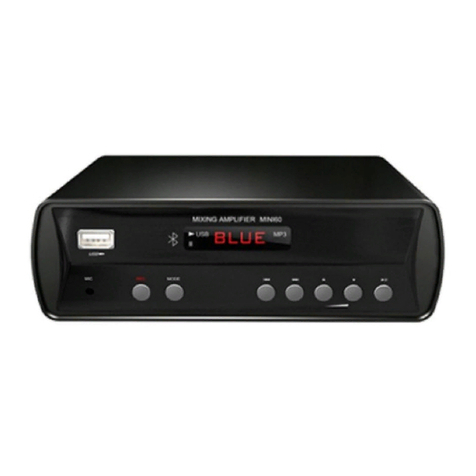
LY International Electronics
LY International Electronics MINI60 owner's manual
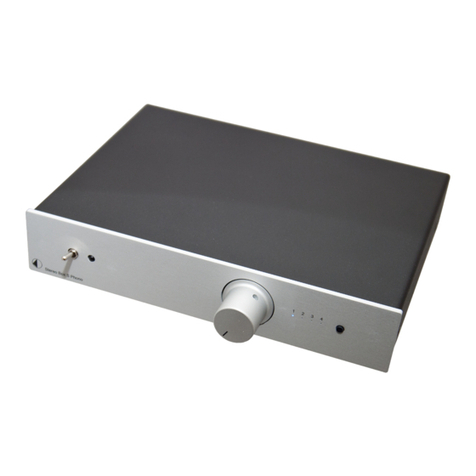
Box-Design
Box-Design Pro-Ject Stereo Box S Phono Instructions for use
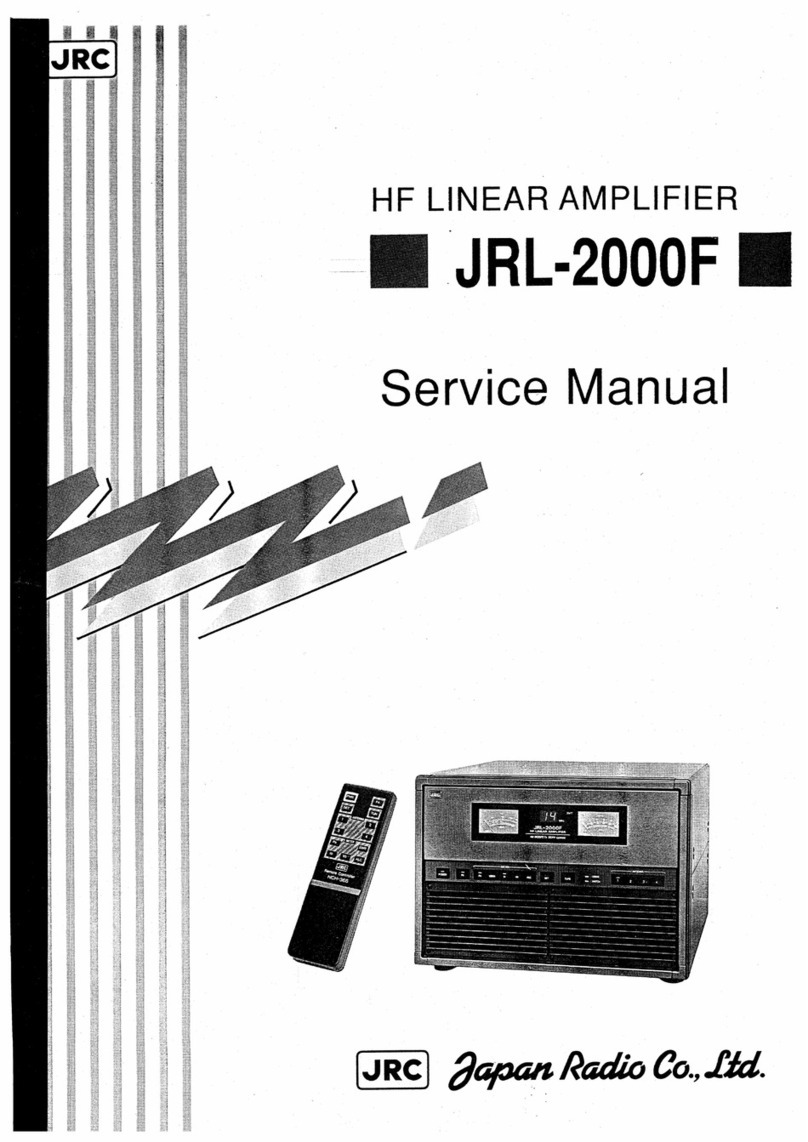
JRC
JRC JRL-2000F Service manual
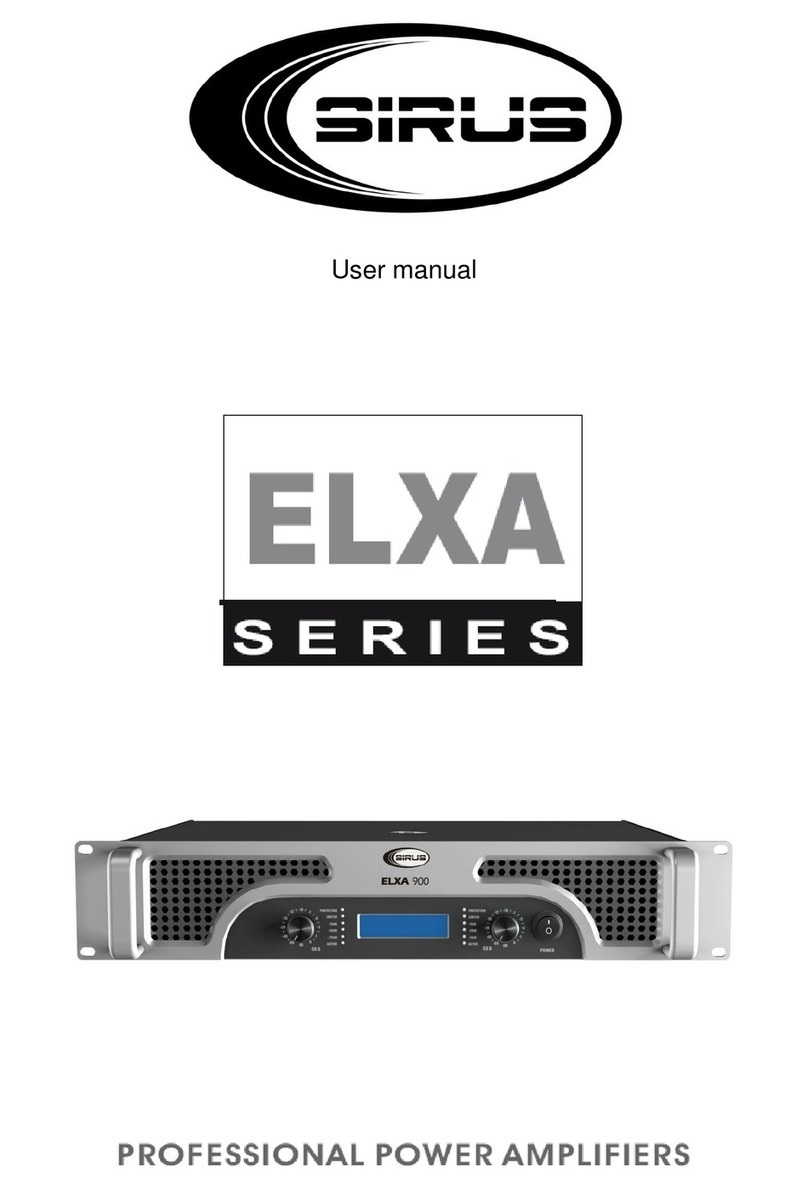
Sirus
Sirus ELXA Series user manual

Audio Research
Audio Research VT130 owner's manual
